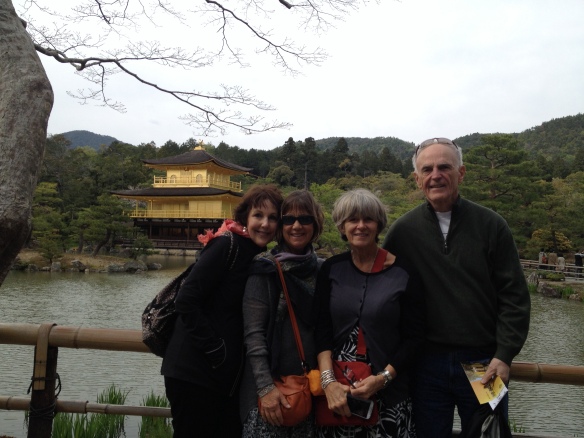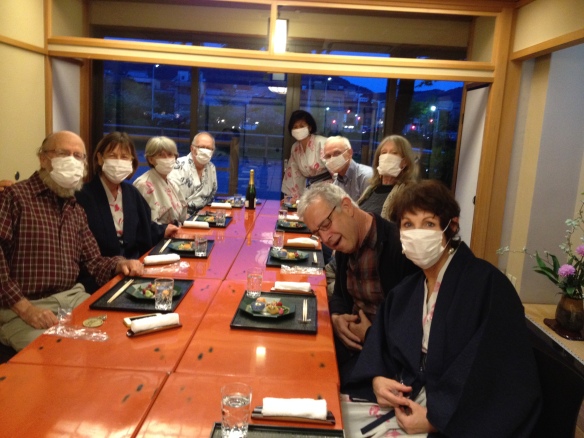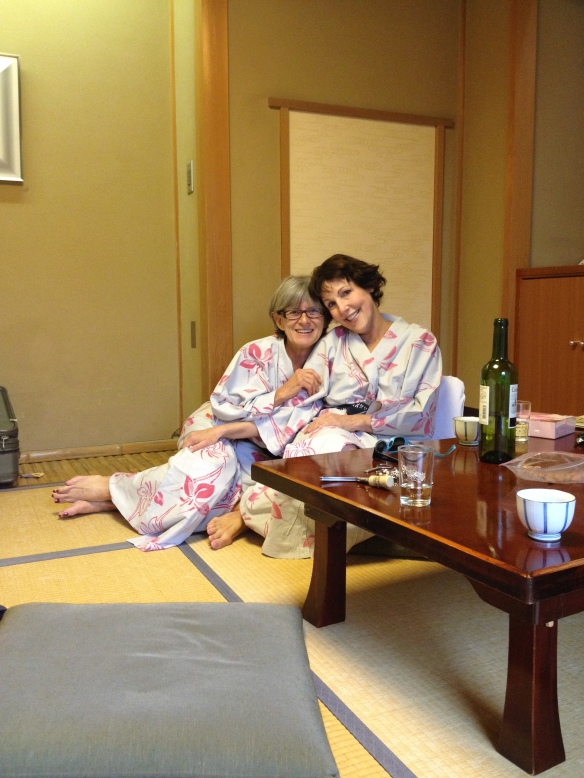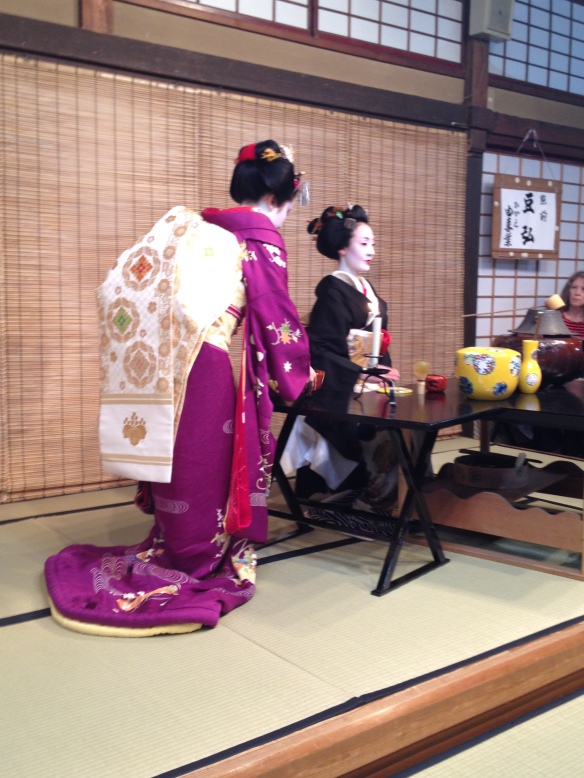In the center of Kyoto, inspiring natives and tourists alike with the beauty of nature and dotted with Buddhist Temples and Shinto Shrines, lays Maruyama Park. It is Kyoto’s version of New York City’s Central Park. Wendy and I walk regularly at home in Healdsburg. More than 45 years ago Wendy lived in Kyoto. One of my favorite mornings of the trip was when she took me to this park, early one morning, prior to the onset of tourists — when the park was quiet and only the sound of drum beats and a gentle wind could be heard. We walked for what seemed to be forever, passing nuns and ancient cemeteries and blossoming trees and flowers of all kinds, shapes, and colors. It was magical to be here in the quiet hours of daybreak. 

 Maruyama Park was deserted and overgrown with shrubs and weeds until three hundred years ago. In 1886, it was designated as a park site at which time it was enlarged. In 1913, it was professionally designed by Jihei Ogawa, a landscape gardener who had previously designed the well-known gardens of Heian Shrine and Murin-an. We were told that it was a typical Japanese park especially noted for its big dropping cheery trees and various other varieties of these trees. To stroll through this park relatively alone at the height of cherry blossom season provides a memory to be cherished.
Maruyama Park was deserted and overgrown with shrubs and weeds until three hundred years ago. In 1886, it was designated as a park site at which time it was enlarged. In 1913, it was professionally designed by Jihei Ogawa, a landscape gardener who had previously designed the well-known gardens of Heian Shrine and Murin-an. We were told that it was a typical Japanese park especially noted for its big dropping cheery trees and various other varieties of these trees. To stroll through this park relatively alone at the height of cherry blossom season provides a memory to be cherished.



Tag Archives: Kyoto travel
Miho Museum and Wappado Restaurant
I’m not much of a map person, and for me one of the joys of traveling is not knowing what to expect or how to get there. So yesterday was a rather magical day from this perspective. After a short walk, a longer bus ride, four stops on the subway, and another 50 minute bus ride, we had our first venture ascending into the mountains of Japan. Following a bubbling brook, we climbed the mountain on a narrow road where erosion was evident with road construction around nearly every corner. Flowers were abundant with colors of pink I’ve never before seen, and reds, violets and blues. We finally reached our destination, The Miho Museum, where above the fog we arrived in Shangri-La. In Osaka, we had missed the Cherry blossoms by about 5 days but here in the mountains we followed a natural tunnel of Cherry Trees in full bloom. The petals were blowing and the trees were raining blossoms.



 Words really can’t describe the experience of the approach through the blossoms to renowned Architect I.M. Pei’s exquisite Miho Museum. The geometric-designed museum was built 80% below the ground, to bring the building into harmony with the environment and the surrounding view. I have visited many museums throughout the world and this experience offered a spiritual moment in life. The collection contains over 2,000 works from Japanese Tea Ceremonial art, Buddhist art and ceramics to art from Asian and Western cultures. Yet the true experience of the Miho is how I.M. Pei and the founders integrated and celebrated nature as the primary exhibit. With Cherry blossoms in full bloom as it was designed to display, we were blessed beyond words to be there. AND, this was merely our day time activity.
Words really can’t describe the experience of the approach through the blossoms to renowned Architect I.M. Pei’s exquisite Miho Museum. The geometric-designed museum was built 80% below the ground, to bring the building into harmony with the environment and the surrounding view. I have visited many museums throughout the world and this experience offered a spiritual moment in life. The collection contains over 2,000 works from Japanese Tea Ceremonial art, Buddhist art and ceramics to art from Asian and Western cultures. Yet the true experience of the Miho is how I.M. Pei and the founders integrated and celebrated nature as the primary exhibit. With Cherry blossoms in full bloom as it was designed to display, we were blessed beyond words to be there. AND, this was merely our day time activity.



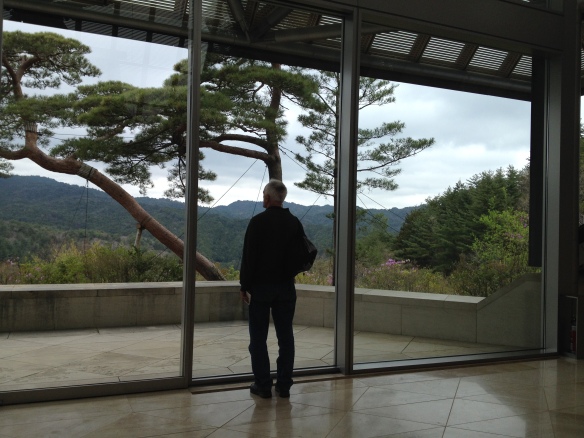 As evening approached, we loaded into two taxis for a long drive in the opposite direction. Once again we climbed hills and dales. We were convinced that our driver was trained in Tokyo, as he maneuvered his cell phone while making hairpin turns. It was a bit tricky finding Wappado Restaurant, www.wappado.jp – but well worth the drive and adventure.
As evening approached, we loaded into two taxis for a long drive in the opposite direction. Once again we climbed hills and dales. We were convinced that our driver was trained in Tokyo, as he maneuvered his cell phone while making hairpin turns. It was a bit tricky finding Wappado Restaurant, www.wappado.jp – but well worth the drive and adventure.
With a light rain beginning and mist and dusk setting in, we got out of the cab on to a very narrow, rocky road surrounded by a patchwork quilt of farm land. Small plots of family farms dotted the landscape and went as far as the eye could see. Wappado is one of the few farm-to-table restaurants in Kyoto, i.e. Japan, as Kyoto is the gastronomic capital of this country. The owners are husband and wife, he the chef, she the sous chef and mother of their 7 and 3 year old children. The restaurant is their charming farmhouse and we were the only diners that night. They are open Friday – Sunday only, as the rest of the time their garden and family obligations command their attention. Let it suffice to say that our eight-course, exquisitely prepared and presented meal was freshly picked from their garden. The subtle flavors were unimaginable as John and Mei tried to identify what we were tasting. The mother-in-law is a weaver, so after dinner many of us wanted to further support this young family by purchasing the beautifully crafted hand woven scarves, mats, etc.
Wappado is one of the few farm-to-table restaurants in Kyoto, i.e. Japan, as Kyoto is the gastronomic capital of this country. The owners are husband and wife, he the chef, she the sous chef and mother of their 7 and 3 year old children. The restaurant is their charming farmhouse and we were the only diners that night. They are open Friday – Sunday only, as the rest of the time their garden and family obligations command their attention. Let it suffice to say that our eight-course, exquisitely prepared and presented meal was freshly picked from their garden. The subtle flavors were unimaginable as John and Mei tried to identify what we were tasting. The mother-in-law is a weaver, so after dinner many of us wanted to further support this young family by purchasing the beautifully crafted hand woven scarves, mats, etc.

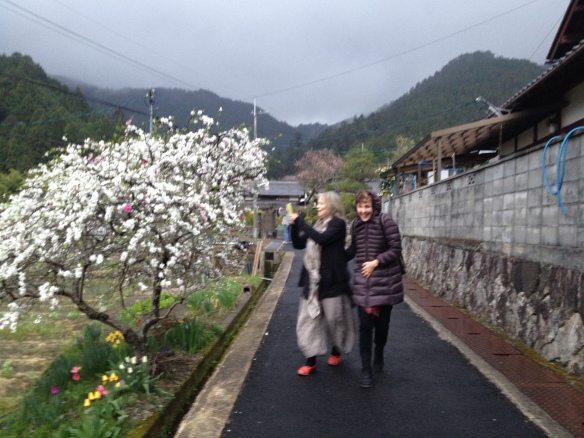



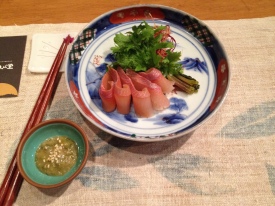


 Ahhhhh, thank you Mei for this once in a lifetime farm to table experience in Kyoto!
Ahhhhh, thank you Mei for this once in a lifetime farm to table experience in Kyoto! 
Day 5 in Japan – Imagine spending a birthday in Kyoto with dear friends, during Cherry Blossom season! Lucky me!
We began this beautiful birthday with 64 degree sunny weather at the National Treasure Sanjusangen-do. The principal images of this temple are the 1001 statues of the Buddhist deity Juichimen-senju-sengen Kanzeon… AKA “Kannon.” The 1001 Buddhas are made of Japanese cypress wood covered in gold, and are 700 years old. It took 70 artists 100 years to complete these Buddhas… Each of the Buddhas has 11 faces and 21 pairs of arms which totals 1000 arms, and as the story goes, with treasures in each hand saves 25 worlds. It is believed that Kannon Bodhisattva can transform himself into 33 different figures. Therefore, the 1001 images really equal 33,000. Can’t really say that I understand this all too well… but it was impressive to see.
In the center of these Buddha figures is a larger Buddha that was had carved by a famous 82 year old artist.
Next, we visited the Nijo Castle. It is a UNESCO World Heritage Site. Originally built in 1603, it was the official Kyoto residence of the first Tokugaway Shogun. In 1867, when Yoshinobu, the fifteenth Tokugawa Shogun returned sovereignty to the Emperor, the castle became the property of the Imperial family. It was donated to the City of Kyoto and renamed Nijo Castle in 1939.
Our final destination was the “Must See” Kinkaku or The Golden Pavilion. It is literally made of gold and sits stunningly on an island surrounded by Maple & Cherry Trees among other stunning landscape. It was overcast today, so didn’t see the gold temple and Cherry Blossoms reflected in the lake, but photos show that it is breathtaking in both spring and again in fall with the changing colors of the maple trees.
My birthday celebration was spent with a Champagne dinner at the Ryokan, where dressed in Kimonos, we indulged in an 18 course traditional Japanese dinner.
Certainly a birthday I will always treasure. Thank you, dear travel mates and friends!
Day 4 in Japan – Osaka to Kyoto
A chartered bus transported our group the hour and a half drive from Osaka to Kyoto where we passed through the industrial section of Osaka on the outskirts of town. Just prior to arriving in Kyoto, low houses with Japanese style roofs lined the river as we moved into the countryside. 

Kyoto is a city much smaller than Osaka with the charm of traditional Japan complemented by influences of the modern world. Our first two nights are spent at a Ryokan, which is a traditional Japanese style hotel or inn. Our inn respects the unique and subtle beauty of Japanese culture and custom. We sleep on futons on tatami mat floors and have public baths for both men and woman in addition to deep soaking tubs in each room. We are offered Japanese Kimonos with formal silk jackets to wear for breakfast and dinner. The dinners are 16 courses of traditional Japanese food served in exquisite ceramic bowls where the artistry is as sensual as the textures of the food. Breakfast was a real treat with a cold soft boiled egg and rice, ginger and a score of other condiments.
The first temple we visited was Tenryu-ji Temple, which is a World Cultural Heritage Site. It is the head temple of the Tenryu-ji branch of Rinzai Zen Buddhism and was established in 1339, by the shogun Ashikaga Takauji in memory of Emperor Go-Daigo. Throughout the years, it has been ravaged by fires more than eight times, most recently in 1864. However, the magnificent landscaped garden behind the main hall is one of the oldest in Japan, retaining the same form as when it was designed by Muso Soseki in the 14th century. It was the first Special Historical Scenic Area named by the Japanese government, and in 1994 was designated by the United Nations as a World Cultural Heritage site. The garden is a MUST SEE. 


After a traditional Japanese lunch with fish, tempura and other delicacies, we went to a high tea ceremony (which was a joke and really more of a photo op of Geisha and Maiko girls). The tea ceremony, such as it was, was a prelude to a Geisha performance. All of the actors and musicians were females. The sets and costumes were breathtaking, colorful, and quite impressive. Otherwise, the show was a bit commercial for our taste.








